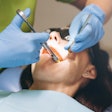
IV moderate sedation dentistry is extremely safe for the patient if administered correctly by a dentist who has been properly trained and certified to perform IV sedation. That being said, there is a protocol to obtaining the proper qualifications to practice IV sedation dentistry and for monitoring a patient who is under IV sedation during a dental procedure.
Below are five things to consider.
 Laurence Fendrich, DMD.
Laurence Fendrich, DMD.1. Licensure
Only certain dentists are licensed to practice IV sedation dentistry.
The level of sedation you want to be licensed for determines what qualifications are needed to obtain a permit within the state that you currently practice dentistry. For IV conscious/moderate sedation, most states usually require a minimum of 40 to 60 hours of didactic coursework and between 40 and 60 hours of clinical work with patients.
Typically, dentists will need to complete supervised treatment on more than 20 patients in the course of this training. Once training is completed and proof of study and case completion are provided, a permit can be applied for within the dentist's practicing state to use IV sedation on patients.
2. Sedation methods
There are four methods for sedating a patient during an in-office dental procedure: anxiolytic or minimal sedation; conscious/moderate sedation; deep sedation; and finally, general anesthesia. I recommend for the average dental practitioner, minimal or moderate sedation because the patient is breathing on his or her own and can respond to verbal commands and painful stimuli.
The rule for a practice should always be: Why go deeper if you don't have to? Err on the side of conservatism when sedating a patient for dental work. As with anything in medicine, weighing the benefits versus the risks when it comes to dental sedation practice is wise.
3. Remain in the room
When administering IV conscious sedation to a patient, the dentist must usually remain in the room with that patient at all times. Under these circumstances, dentists cannot resume their normal routine where they may be practicing in more than one chair at the same time. When practicing IV moderate sedation dentistry, the dentist is usually with one patient at a time from start to finish.
Working on a moderately sedated patient allows a dentist to accomplish much more work in a short period of time and without patient discomfort. This means that years of dental neglect can sometimes be reversed and smiles restored in as little as one restful visit. The medication used during moderate IV sedation also offers amnesiac properties, so the patient will remember little to nothing about the procedure on waking up.
Once the procedure is completed, adequate recovery time is needed before discharging a patient out of your care. The patient has to be completely awake, aware, cognizant of their surroundings, and able to answer basic questions. Most states require a recovery room or chair for this purpose.
4. Pediatric patients
As with any type of sedation, certain restrictions and exceptions need to be considered when practicing IV sedation dentistry. Earning a permit to administer IV sedation to adults usually does not permit dentists to administer IV sedation to pediatric patients. Children can respond differently than many adults to sedation medications, so further training is usually required, and many states require a special permit to perform IV sedation on children.
Another exception would be someone who is medically compromised or unstable. For example, if a patient has uncontrolled high blood pressure or diabetes, or a recent history of stroke, he or she should be considered medically unstable and, therefore, not a good candidate for IV sedation dentistry. However, if overall health is stable, then the patient would generally be a good candidate for IV sedation dentistry.
5. Safety
I want to stress that IV sedation dentistry is extremely safe and effective. There are many reasons for me saying this: One of the main reasons is that throughout the sedation you are slowly titrating drugs into the patient's system, as opposed to pushing a set amount of a drug all at once. As you are titrating medication, you are continually monitoring the patient to determine if more or less medication is needed to achieve the desired sedative effect throughout a given dental procedure.
IV sedation dentistry is a wonderful option for many patients who would normally avoid the dentist out of fear. These patients will be more apt to come in for routine maintenance and also bigger dental work, as needed, if they can bypass the fear of a needle and the perceived pain associated with going to the dentist.
Laurence Fendrich, DMD, is a dentist with offices in New York City (dentistonmadison.com) and in Lighthouse Point, FL (dentalsedationgroup.com). Follow him on Twitter @DentistOnMad and Facebook.com/MadisonAvenueDentistry.
The comments and observations expressed herein do not necessarily reflect the opinions of DrBicuspid.com, nor should they be construed as an endorsement or admonishment of any particular idea, vendor, or organization.



















